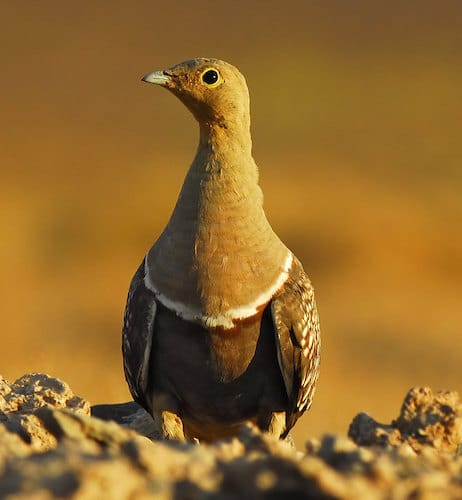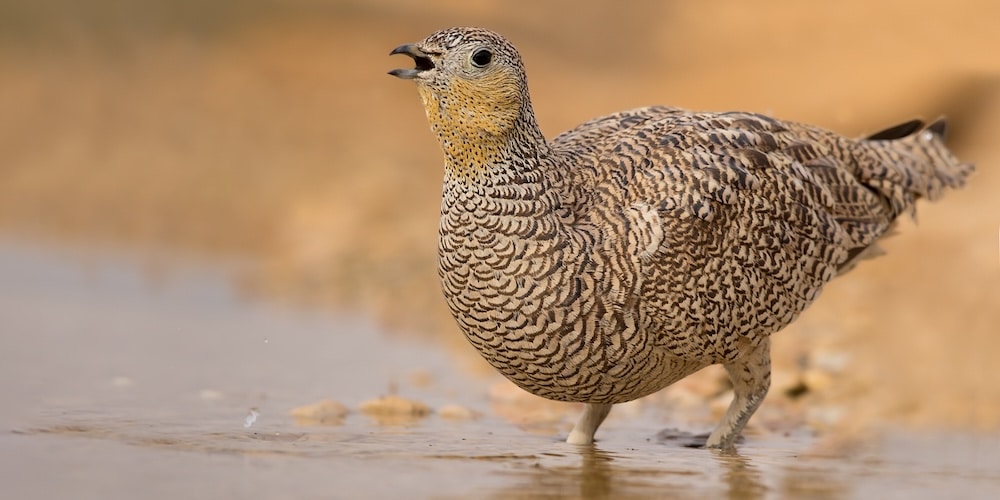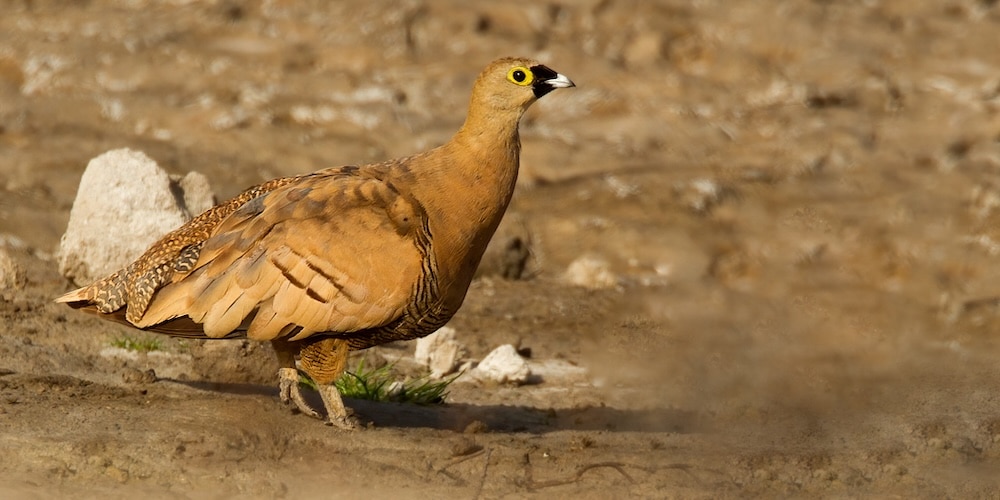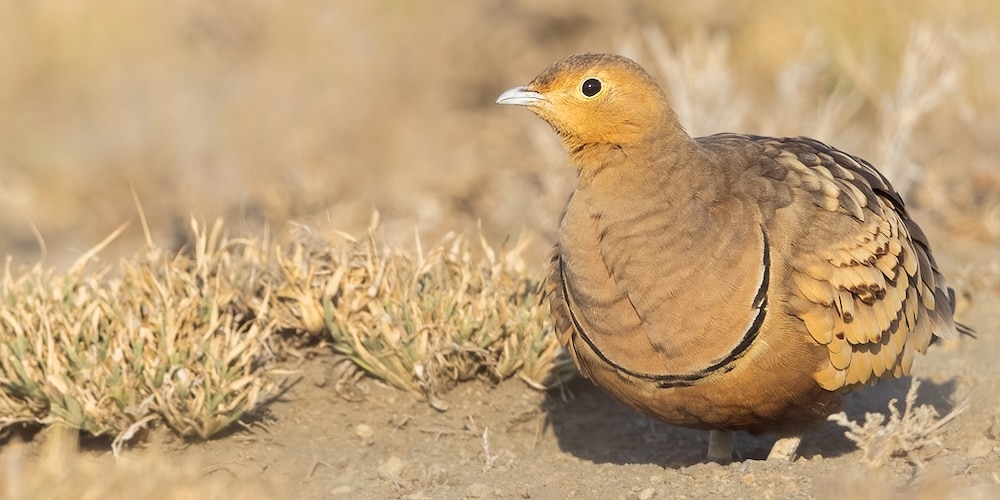Pteroclidae – Sandgrouse

The Pteroclididae or Sandgrouse is a family of sixteen species of birds, in just two genera. They are the sole members of the order Pteroclidiformes. The two central Asian species are classified as Syrrhaptes and the other fourteen species, from Africa and Asia, are placed in the genus Pterocles. They are ground dwelling birds restricted to treeless, open country, such as plains, savannahs and semi-deserts. They are distributed across northern, southern and eastern Africa, Madagascar, the Middle East and India through to central Asia. The ranges of the Black-bellied Sandgrouse and the Pin-tailed Sandgrouse extend into the Iberian Peninsula and France, and Pallas’s Sandgrouse occasionally breaks out in large numbers from its normal range in Asia.
Sandgrouse have small, pigeon-like heads and necks and sturdy compact bodies. They range in size from 24cm to 40cm in length and from 150g to 500g in weight. The adults are sexually dimorphic with the males being slightly larger and more brightly coloured than the females. They have eleven strong primary feathers and long pointed wings giving them a fast direct flight. The muscles of the wings are powerful and the birds are capable of rapid take-off and sustained flight. In some species, the central feathers in the tail are extended into long points. The legs are short and members of the genus Syrrhaptes have feathers growing on both the legs and toes and no hind toes, while members of the genus Pterocles have legs feathered just at the front, no feathers on the toes and rudimentary hind toes raised off the ground.

(Female) Crowned Sandgrouse Pterocles coronatus – ©Dubi Shapiro
The plumage is cryptic, generally being in shades of sandy brown, grey and buff, variously mottled and barred, enabling the birds to merge into the dusty landscape. There is a dense layer of under down which helps insulate the bird from extremes of heat and cold. The feathers of the belly are specially adapted for absorbing water and retaining it, allowing adults, particularly males, to carry water to chicks that may be many miles away from watering holes. The amount of water that can be carried in this way is 15 to 20 millilitres.

Madagascar Sandgrouse Pterocles personatus – ©Dubi Shapiro
Sandgrouse are principally seed eaters. Other food items eaten include green shoots and leaves, bulbs and berries. Insect food such as ants and termites may be eaten especially during the breeding season. The diet of many sandgrouse is highly specialised, with the seeds of a small number of plant species being dominant. This may depend on local availability but in other cases it reflects actual selection of favoured seeds over others by the sandgrouse. Seeds of leguminous plants are usually an important part of the diet. In agricultural areas oats and other grain are readily taken. Seeds are either collected from the ground or directly from the plants. Foraging techniques vary between species that coexist which reduces competition; in Namibia, Double-banded Sandgrouse feed slowly and methodically whilst Namaqua Sandgrouse feed rapidly, exploring loose soil with their beaks and flicking it away sideways. Grit is also swallowed to help grind up food in the gizzard. Sandgrouse are gregarious, feeding in flocks of up to 100 birds. As a consequence of their dry diet, they need to visit water sources regularly. Drinking times vary among the species.

Chestnut-bellied Sandgrouse Pterocles exustus – ©Dubi Shapiro
Sandgrouse are monogamous. The breeding season usually coincides with a crop of seeds after the local rainy season and at this time, the feeding flocks tend to break up into pairs. The nesting site is a slight depression in the ground, sometimes lined with a few pieces of dry foliage. Most typically, three cryptic eggs are laid, though occasionally there may be two or four. Incubation duties are shared and, in most species, the males incubate at night while the females sit on the eggs during the day. The eggs usually hatch after 20 to 25 days. The precocial chicks are covered with down and leave the nest as soon as the last hatchling has dried out. The parents do not provide them with food and they learn, with parental guidance, what is edible and what is not. The chicks obtain their water from the soaked downy feathers on the adults’ breasts. At first the chicks are too small and young to thermoregulate, and are provided with shade during the hottest part of the day and brooded at night. They remain with their parents, as a family group, for several months.
-
Number of bird species: 16
(As at September 2025)
The recently (2025) amalgamated AviList recognises that there are sixteen species in just two genera in the family Pteroclididae; the only extant family of Pterocliformes. They are:
Pallas’s Sandgrouse Syrrhaptes paradoxus
Tibetan Sandgrouse Syrrhaptes tibetanus
Pin-tailed Sandgrouse Pterocles alchata
Namaqua Sandgrouse Pterocles namaqua
Chestnut-bellied Sandgrouse Pterocles exustus
Spotted Sandgrouse Pterocles senegallus
Black-bellied Sandgrouse Pterocles orientalis
Yellow-throated Sandgrouse Pterocles gutturalis
Crowned Sandgrouse Pterocles coronatus
Black-faced Sandgrouse Pterocles decoratus
Madagascar Sandgrouse Pterocles personatus
Lichtenstein’s Sandgrouse Pterocles lichtensteinii
Double-banded Sandgrouse Pterocles bicinctus
Four-banded Sandgrouse Pterocles quadricinctus
Painted Sandgrouse Pterocles indicus
Burchell’s Sandgrouse Pterocles burchelli
-
Gamebirds of Africa - Guineafowls, Francolins, Spurfowls, Quails, Sandgrouse & Snipes
| By Rob Little | Jacana | 2021 | Paperback | 340 pages, colour photos, colour distribution maps | ISBN: 9781431430789 Buy this book from NHBS.com -
Pheasants, Partridges & Grouse
| Including Buttonquails, Sandgrouse & Allies | By Steve Madge & Phil McGowan | Helm | 2002 | Hardback | 488 pages, 72 col plates, 257 maps | ISBN: 9780713639667 Buy this book from NHBS.com
-
Pteroclidae
Family AccountThese birds are dove-like in profile and subsist in some of the driest habitats on diets largely of seeds. They forage in flocks, which often grow much larger. -
Pteroclidae
Family AccountSandgrouse is the common name for Pteroclidae, a family of sixteen species of bird, members of the order Pterocliformes...
Given that this is a quite small family with just sixteen species in only two genera, Fatbirder provides active links below to all species.
-
Black-bellied Sandgrouse Pterocles orientalis
Species AccountThe black-bellied sandgrouse (Pterocles orientalis) is a medium large bird in the sandgrouse family. Egg The nominate race breeds in Iberian Peninsula. -
Black-bellied Sandgrouse Pterocles orientalis
Species AccountSound archive and distribution map. -
Black-faced Sandgrouse Pterocles decoratus
Species AccountThe black-faced sandgrouse (Pterocles decoratus) is a species of bird in the Pteroclidae family. It is found in Ethiopia, Kenya, Somalia, Tanzania, and Uganda. -
Black-faced Sandgrouse Pterocles decoratus
Species AccountSound archive and distribution map. -
Burchell's Sandgrouse Pterocles burchelli
Species AccountA plump, small-headed, pigeon-like bird. Mostly chestnut-cinnamon speckled with white; the male has a gray face and yellow spectacles, and the female has a yellowish face. -
Burchell's Sandgrouse Pterocles burchelli
Species AccountSound archive and distribution map. -
Chestnut-bellied Sandgrouse Pterocles exustus
Species AccountA large, plump, and dovelike bird with a pointed tail. Males are sandy brown with a thin black breast band and solid chestnut belly. -
Chestnut-bellied Sandgrouse Pterocles exustus
Species AccountSound archive and distribution map. -
Crowned Sandgrouse Pterocles coronatus
Species AccountThe crowned sandgrouse (Pterocles coronatus) is a species of bird in the sandgrouse family, the Pteroclidae from North Africa and the Middle East. -
Crowned Sandgrouse Pterocles coronatus
Species AccountSound archive and distribution map. -
Double-banded Sandgrouse Pterocles bicinctus
Species AccountThe double-banded sandgrouse (Pterocles bicinctus) is a species of ground-living bird in the family Pteroclididae. It is found in arid parts of southern Africa. -
Double-banded Sandgrouse Pterocles bicinctus
Species AccountSound archive and distribution map. -
Four-banded Sandgrouse Pterocles quadricinctus
Species AccountThe four-banded sandgrouse (Pterocles quadricinctus) is a medium-sized bird in the sandgrouse family. -
Four-banded Sandgrouse Pterocles quadricinctus
Species AccountSound archive and distribution map. -
Lichtenstein's Sandgrouse Pterocles lichtensteinii
Species AccountLichtenstein's sandgrouse (Pterocles lichtensteinii) is a species of bird in the Pteroclidae family, which is named after Martin Lichtenstein. -
Lichtenstein's Sandgrouse Pterocles lichtensteinii
Species AccountSound archive and distribution map. -
Madagascar Sandgrouse Pterocles personatus
Species AccountBrownish bird that is shaped like a large dove. Male has a black front and plain wing with three black bars; female has fine black markings across the back. -
Madagascar Sandgrouse Pterocles personatus
Species AccountSound archive and distribution map. -
Namaqua Sandgrouse Pterocles namaqua
Species AccountNamaqua Sandgrouse is nomadic in desert, semi-desert, and arid savanna. It feeds on grass seed and can frequently be seen coming to drink in the early morning... -
Namaqua Sandgrouse Pterocles namaqua
Species AccountSound archive and distribution map. -
Painted Sandgrouse Pterocles indicus
Species AccountThe painted sandgrouse (Pterocles indicus) is a medium large bird in the sandgrouse family Pteroclidae found in India and Pakistan. -
Painted Sandgrouse Pterocles indicus
Species AccountSound archive and distribution map. -
Pallas's Sandgrouse Syrrhaptes paradoxus
Species AccountThe Pallas's sandgrouse (Syrrhaptes paradoxus) is a medium large bird in the sandgrouse family named after the German zoologist Peter Simon Pallas. -
Pallas's Sandgrouse Syrrhaptes paradoxus
Species AccountSyrrhaptes paradoxus is listed as Least Concern. -
Pallas's Sandgrouse Syrrhaptes paradoxus
Species AccountSound archive and distribution map. -
Pin-tailed Sandgrouse Pterocles alchata
Species AccountThe pin-tailed sandgrouse (Pterocles alchata) is a medium large bird in the sandgrouse family. It has a small, pigeon-like head and neck and a sturdy, compact... -
Pin-tailed Sandgrouse Pterocles alchata
Species AccountSound archive and distribution map. -
Spotted Sandgrouse Pterocles senegallus
Species AccountThe spotted sandgrouse (Pterocles senegallus) is a species of ground dwelling bird in the family Pteroclidae. It is found in arid regions of northern and... -
Spotted Sandgrouse Pterocles senegallus
Species AccountSound archive and distribution map. -
Tibetan Sandgrouse Syrrhaptes tibetanus
Species AccountThe Tibetan sandgrouse (Syrrhaptes tibetanus ) is a large bird in the sandgrouse family. The genus name Syrrhaptes is from Ancient Greek surrhaptos, "sewn together" (the feathered toes of this sandgrouse are fused together) and tibetanus is from the type locality, Tibet. -
Tibetan Sandgrouse Syrrhaptes tibetanus
Species AccountSound archive and distribution map. -
Yellow-throated Sandgrouse Pterocles gutturalis
Species AccountLarger than other African sandgrouse, it has a distinctive black-bordered yellow throat in the male, and heavy mottling and a plain face in the female. -
Yellow-throated Sandgrouse Pterocles gutturalis
Species AccountSound archive and distribution map.
